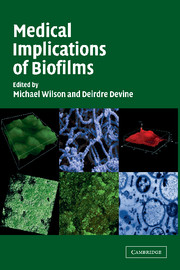Preface
Published online by Cambridge University Press: 23 November 2009
Summary
Biofilms are increasingly recognised as the preferred mode of growth of bacteria in a wide range of sites, including the many, and varied, habitats present in man. Until approximately 10 years ago, biofilms were regarded as consisting simply of an accumulation of bacteria and their products on a surface. But recent technical advances have significantly changed our understanding of biofilm organisation and function. Non-destructive methods of examining organisms in their living, hydrated state (for example, confocal laser scanning microscopy) have revealed that they have an ordered structure, often permeated by water channels which can function as a primitive circulation system. Modern molecular techniques have identified genes that are up- and down-regulated in different regions of a biofilm – this has important implications for assessing the behaviour of organisms in biofilms (for example, virulence potential, susceptibility to antimicrobiol agents, and host defence mechanisms). Furthermore, the discovery of population-dependent gene regulation (quorum sensing) in bacteria has meant revising our concept of bacteria as being independently operating cells. Quorum-regulated gene regulation is, obviously, likely to play an important role in determining the collective properties of bacteria in biofilms.
During the last few years, interest in microbial biofilms has increased dramatically and now encompasses a broad range of disciplines – microbiology, molecular biology, microscopy, medicine, engineering, ecology, and marine biology. This increased specialisation within the field has led to a need for books that focus on particular aspects of biofilms.
- Type
- Chapter
- Information
- Medical Implications of Biofilms , pp. vii - viiiPublisher: Cambridge University PressPrint publication year: 2003



